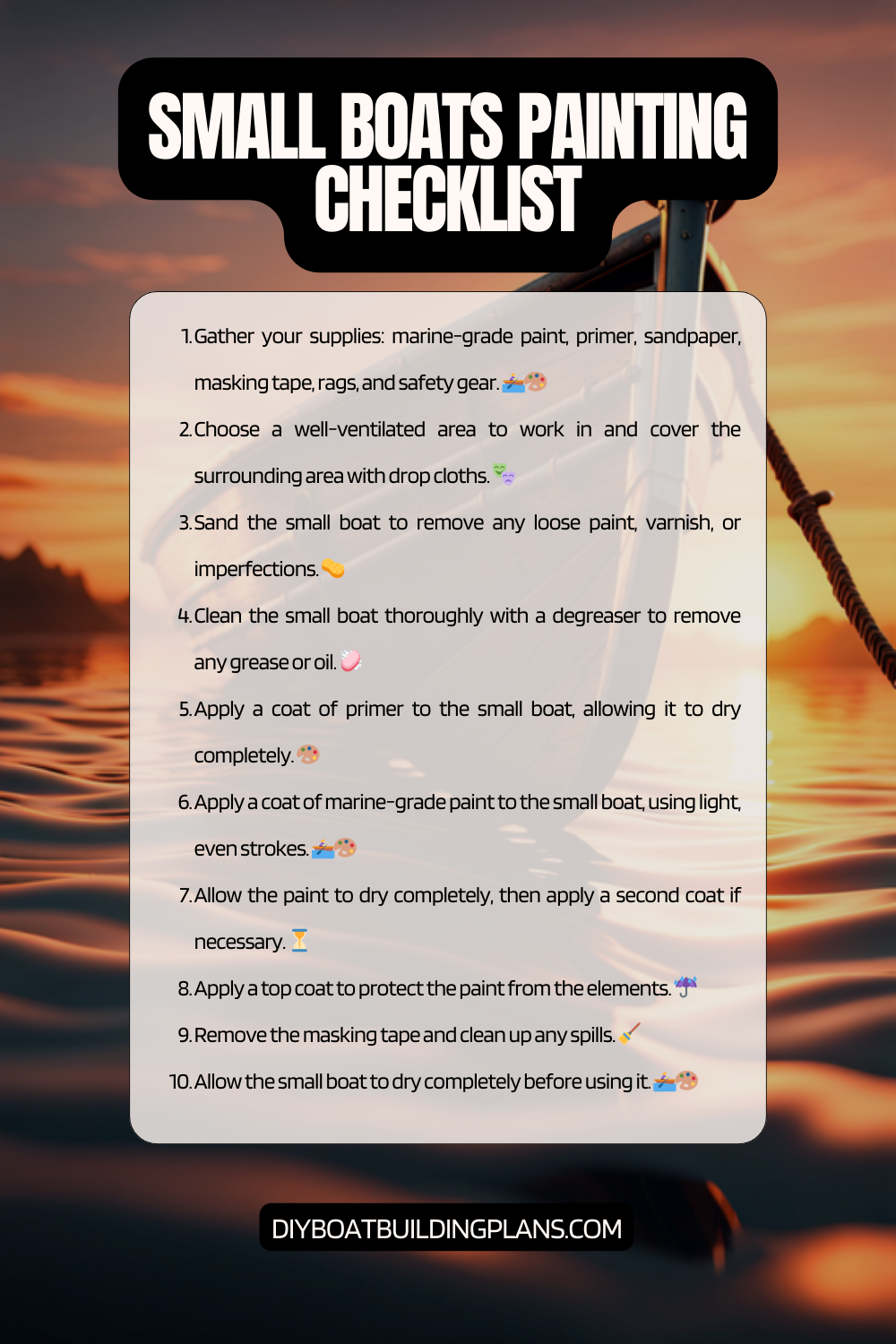Overview of Small Boat Painting Tips
Maintaining the paint job on a small boat is crucial for several reasons. Firstly, a well-painted boat not only enhances its appearance but also protects it from the harsh elements of the water. The paint acts as a barrier against saltwater, UV rays, and other environmental factors that can cause damage to the boat’s structure. Additionally, a well-maintained paint job can increase the resale value of the boat, making it a worthwhile investment for boat owners.
The benefits of a well-painted small boat are numerous. Apart from protecting the boat from corrosion and deterioration, a fresh coat of paint can make the boat look brand new. It adds a touch of elegance and professionalism, making it more appealing to potential buyers or simply enhancing the owner’s pride in their vessel. Furthermore, a well-painted boat is easier to clean and maintain, as dirt and grime are less likely to stick to a smooth surface.
Key Takeaways
- Choose the right paint for your small boat based on its material and usage.
- Properly prepare your boat for painting by cleaning and sanding the surface.
- Apply primer before painting to ensure a smooth and long-lasting finish.
- Use the right brush or roller for your small boat and apply paint in thin, even coats.
- Maintain your small boat’s paint job by regularly cleaning and touching up any chips or scratches.

Choosing the Right Paint for Your Small Boat
When it comes to choosing the right paint for your small boat, there are several factors to consider. Firstly, you need to decide between two main types of paint: antifouling paint and topside paint. Antifouling paint is specifically designed to prevent marine growth such as barnacles and algae from attaching to the hull of the boat. On the other hand, topside paint is used for above-the-waterline areas and comes in various finishes such as gloss, semi-gloss, or matte.
Other factors to consider when choosing paint include durability, color options, and ease of application. It is important to select a paint that can withstand the harsh conditions of being exposed to water, sunlight, and constant movement. Additionally, consider the color options available and choose one that suits your personal preference or matches your boat’s aesthetic. Lastly, opt for a paint that is easy to apply, especially if you plan on doing the painting yourself.
Preparing Your Boat for Painting
Before you can start painting your small boat, it is essential to properly prepare the surface. This involves cleaning the boat, removing any old paint, and repairing any damages. Begin by thoroughly cleaning the boat using a mild detergent and water. Remove any dirt, grime, or grease that may be present on the surface. This will ensure that the paint adheres properly and provides a smooth finish.
Next, remove any old paint that may be peeling or flaking. This can be done using a scraper or sandpaper, depending on the condition of the existing paint. Be sure to wear protective gear such as gloves and goggles to avoid any injuries. Once the old paint has been removed, inspect the boat for any damages such as cracks or dents. Repair these areas using an appropriate filler or epoxy, ensuring a smooth and even surface.
Sanding Techniques for a Smooth Finish
| Technique | Description | Advantages | Disadvantages |
| Hand Sanding | Sanding by hand using sandpaper or sanding blocks. | Controlled sanding, good for small areas, inexpensive. | Time-consuming, inconsistent results, can cause fatigue. |
| Power Sanding | Sanding using power tools such as orbital sanders or belt sanders. | Efficient, consistent results, good for large areas. | Expensive, can cause damage if not used properly, noisy. |
| Wet Sanding | Sanding using water to lubricate the surface and prevent dust. | Smooth finish, reduces dust, good for finishing coats. | Messy, requires more time and effort, can cause rust if not dried properly. |
| Buffing | Using a buffing wheel or pad to polish the surface. | High gloss finish, removes scratches and imperfections. | Requires special equipment, can be expensive, can cause heat damage if not used properly. |
Sanding is a crucial step in achieving a smooth and professional-looking finish on your small boat. It helps to remove any imperfections, roughness, or unevenness on the surface, allowing the paint to adhere properly. When sanding your boat, it is important to use the right type of sandpaper and employ proper techniques.
The type of sandpaper you choose will depend on the condition of your boat’s surface. For removing old paint or rough areas, start with a coarse-grit sandpaper such as 80 or 120 grit. As you progress towards achieving a smoother finish, switch to finer-grit sandpaper such as 220 or 320 grit. This will help to eliminate any visible scratches or marks left by the coarser sandpaper.
When sanding, it is important to use even pressure and make long, smooth strokes in the direction of the grain. Avoid applying too much pressure as it can damage the surface of the boat. Additionally, periodically check the surface with your hand to ensure it feels smooth and even. Once you have finished sanding, clean the boat again to remove any dust or debris before moving on to the next step.
Applying Primer to Your Small Boat
Applying primer is a crucial step in the painting process as it helps to create a strong bond between the paint and the boat’s surface. It also provides an additional layer of protection against corrosion and enhances the durability of the paint job. When choosing a primer for your small boat, consider factors such as compatibility with the paint you will be using, its ability to adhere to different surfaces, and its resistance to water and UV rays.
There are different types of primers available, including epoxy primers, etching primers, and self-etching primers. Epoxy primers are known for their excellent adhesion and corrosion resistance, making them suitable for boats that will be exposed to harsh conditions. Etching primers are designed to provide a strong bond on bare metal surfaces, while self-etching primers are specifically formulated for use on fiberglass or aluminum boats.
When applying primer, follow the manufacturer’s instructions regarding mixing ratios and application techniques. Use a brush or roller suitable for the type of primer you are using and apply thin, even coats. Allow each coat to dry completely before applying additional coats or moving on to the next step.
Tips for Painting in Different Weather Conditions
The weather conditions during the painting process can greatly affect the outcome of your small boat’s paint job. Ideally, you should choose a day with mild temperatures, low humidity, and no rain or strong winds. However, if you find yourself needing to paint in less than ideal conditions, there are some tips that can help you achieve satisfactory results.
In hot weather, it is important to work quickly and avoid painting in direct sunlight. The heat can cause the paint to dry too quickly, leading to brush marks or an uneven finish. To combat this, paint in the early morning or late afternoon when the temperatures are cooler. If necessary, use a paint additive or conditioner to slow down the drying time of the paint.
In cold weather, it is crucial to ensure that the paint and surface are at the recommended temperature for application. Cold temperatures can cause the paint to thicken and become difficult to work with. Store the paint in a warm area prior to painting and consider using a heat gun or space heater to warm up the boat’s surface if needed.
In humid weather, it is important to take precautions to prevent moisture from affecting the paint job. Avoid painting on days with high humidity or when rain is expected. If necessary, use a dehumidifier or fan to reduce humidity levels in the painting area. Additionally, allow ample drying time between coats to ensure that each layer has properly cured.
Choosing the Right Brush or Roller for Your Small Boat
Choosing the right brush or roller for your small boat is essential for achieving a smooth and even coat of paint. The type of brush or roller you choose will depend on the type of paint you are using and the surface you are painting.
For topside paint, synthetic bristle brushes are recommended as they provide a smooth finish and are easy to clean. Natural bristle brushes should be avoided as they can absorb water and become limp, resulting in an uneven application of paint.
When it comes to rollers, foam rollers are often preferred for their ability to provide a smooth finish without leaving behind lint or fibers. However, foam rollers may not be suitable for all types of paint, so be sure to check the manufacturer’s recommendations. For antifouling paint, it is best to use a short-nap roller specifically designed for this type of paint.
Consider the size of the brush or roller as well. For smaller areas or intricate details, opt for a smaller brush or roller to ensure better control and precision. For larger areas, a larger brush or roller will help to cover more surface area in less time.
Applying Paint to Your Small Boat
When it comes to applying paint to your small boat, there are several techniques that can help you achieve an even and professional-looking coat. Start by pouring the paint into a paint tray or bucket, ensuring that it is mixed thoroughly if necessary.
If using a brush, dip the bristles about one-third of the way into the paint and tap off any excess. Apply the paint using long, smooth strokes in the direction of the grain or contours of the boat. Avoid applying too much pressure as it can cause brush marks or streaks. Instead, use a light touch and let the bristles do the work.
If using a roller, pour the paint into a roller tray and saturate the roller evenly. Roll off any excess paint on the tray’s ridges to prevent drips. Apply the paint using light pressure and make overlapping strokes to ensure even coverage. Work in small sections at a time, blending each section into the next to avoid visible lines or edges.
Techniques for Achieving a Professional-Looking Finish
To achieve a professional-looking finish on your small boat, there are several techniques you can employ to avoid common pitfalls such as drips, runs, or an uneven coat.
Firstly, avoid overloading your brush or roller with paint. Excess paint can lead to drips and runs, resulting in an uneven finish. Instead, apply thin coats of paint and allow each coat to dry completely before applying additional coats.
Secondly, maintain a wet edge while painting. This means working quickly and efficiently to ensure that each stroke blends seamlessly with the previous one. If you allow the paint to dry partially before applying the next stroke, it can result in visible lines or edges.
Thirdly, pay attention to the direction of your brush or roller strokes. Try to follow the natural contours or grain of the boat to achieve a smooth and uniform finish. Avoid changing directions mid-stroke as it can create visible lines or marks.
Lastly, be patient and take your time. Rushing the painting process can lead to mistakes and a subpar finish. Allow each coat of paint to dry completely before applying additional coats or moving on to the next step. This will ensure that the paint cures properly and provides a durable and long-lasting finish.
Download over 500 Boat Plans. Click on the link below.
-->Click Here<--
Maintaining Your Small Boat’s Paint Job
Once you have successfully painted your small boat, it is important to maintain the paint job to ensure its longevity and appearance. Regular maintenance can help prevent damage, fading, or peeling of the paint.
To maintain the paint job, regularly wash your boat with mild detergent and water to remove dirt, salt, and other contaminants. Avoid using abrasive cleaners or brushes that can scratch or damage the paint. Additionally, waxing your boat periodically can provide an extra layer of protection against UV rays and help maintain its shine.
Inspect your boat regularly for any signs of damage such as chips, scratches, or peeling paint. Touch up these areas promptly using matching paint to prevent further deterioration. It is also important to address any underlying issues that may be causing damage to the paint, such as leaks or structural problems.
Lastly, store your boat properly when not in use. Exposure to harsh weather conditions or prolonged sunlight can accelerate paint fading and deterioration. If possible, store your boat in a covered area or use a boat cover to protect it from the elements.
Common Mistakes to Avoid When Painting Your Small Boat
When painting your small boat, there are several common mistakes that you should be aware of and avoid.
One common mistake is not properly preparing the surface before painting. Failing to clean the boat, remove old paint, or repair damages can result in a poor paint job that does not adhere properly or lasts long. Take the time to thoroughly prepare the surface to ensure the best results.
Another mistake is applying too thick of a coat of paint. Thick coats can lead to drips, runs, and an uneven finish. Instead, apply thin coats and allow each coat to dry completely before applying additional coats.
Using the wrong type of paint or primer is another common mistake. Make sure to choose paints and primers that are specifically designed for marine use and are compatible with the surface you are painting. Using the wrong type of paint can result in poor adhesion, peeling, or premature fading.
Lastly, rushing the painting process is a mistake that can lead to subpar results. Take your time, follow proper techniques, and allow each coat of paint to dry completely before moving on to the next step. Patience and attention to detail will ensure a professional-looking finish.
Small Boat Painting Checklist

Conclusion – Small Boat Painting Tips
In conclusion, maintaining a well-painted small boat is essential for both its appearance and protection. Choosing the right paint and properly preparing the surface are crucial steps in achieving a successful paint job. Sanding techniques, applying primer, and using the right tools are important factors in achieving a smooth and even finish.
Painting in ideal weather conditions and avoiding common mistakes will help you achieve professional-looking results. Regular maintenance and addressing any damages promptly will ensure the longevity of your small boat’s paint job. By following these tips and techniques, you can enjoy a beautifully painted small boat that stands out on the water.
FAQs – Small Boat Painting Tips
What are small boat painting tips?
Small boat painting tips are techniques and guidelines that can help you achieve a professional-looking paint job on your small boat. These tips can include preparation, painting techniques, and maintenance.
What are some common mistakes to avoid when painting a small boat?
Some common mistakes to avoid when painting a small boat include not properly preparing the surface, using the wrong type of paint, not applying enough coats, and not allowing enough time for the paint to dry.
What type of paint should I use for my small boat?
The type of paint you should use for your small boat depends on the material of your boat and the type of water it will be used in. Generally, marine-grade paints are recommended for boats, as they are designed to withstand the harsh marine environment.
How do I prepare my small boat for painting?
To prepare your small boat for painting, you should first clean the surface thoroughly and remove any old paint or coatings. You may also need to sand the surface to create a smooth, even surface for the new paint to adhere to.
What painting techniques should I use for my small boat?
When painting a small boat, it is important to use even strokes and apply the paint in thin, even coats. You should also work in small sections and allow each coat to dry completely before applying the next.
How do I maintain the paint on my small boat?
To maintain the paint on your small boat, you should regularly clean the surface and touch up any areas that may have been scratched or damaged. You should also avoid exposing your boat to harsh weather conditions and store it properly when not in use.



